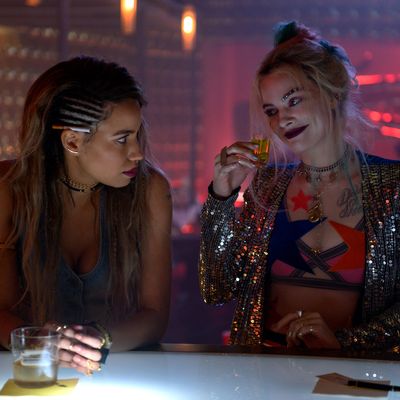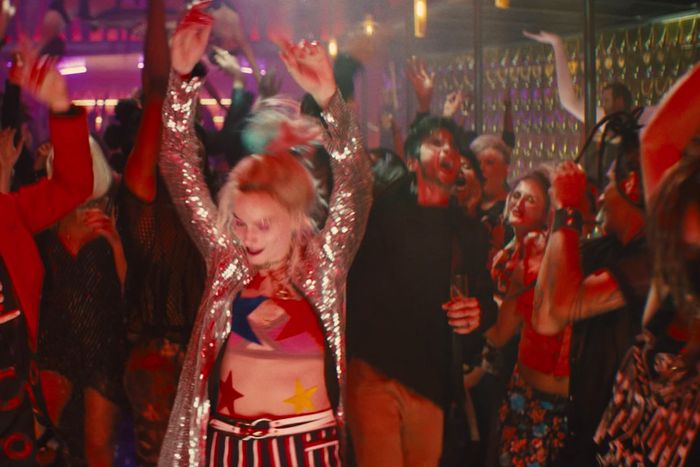
Birds of Prey starts with a breakup. After getting to know Margot RobbieÔÇÖs Harley Quinn as the obsessively devoted girlfriend to the Joker in Suicide Squad, director Cathy YanÔÇÖs new movie kicks off her grand tour of emancipation by showing her literally kicked to the curb by one of Mr. J.ÔÇÖs thugs. Soon after, sheÔÇÖs crying, piping Cheese Whiz into her mouth, giving herself a sad haircut, and desperately toying with new hobbies. But thatÔÇÖs just the setup for a movie thatÔÇÖs more raucous Technicolor chaos than somber pity party.
Prey quickly morphs into a glitter-gun of a film that places dreary Gotham into a Harley-centric snow globe and shakes it up as a neighborhood filled with slapstick criminals and superheroes alike. HarleyÔÇÖs primary goal is to either evade or eliminate the enemies out to kill her now that sheÔÇÖs no longer under JokerÔÇÖs protection, and the fun is the ÔÇ£friendsÔÇØ she makes along the ÔÇö violent ÔÇö way. Their fight scenes take place in exaggerated clouds of cocaine, in fun houses, atop roller skates. One scene early on involves a dizzying single shot of Harley hoovering drugs, congo-ing at the club, and spewing green vomit into a purse. Wonder Woman, this is not.
While the latest DC spinoff saw a more than respectable box-office debut, a $200 million global return pales in comparison to other family-friendly superhero blockbusters. It surely didnÔÇÖt help that Birds debuted just as theaters in some major film markets were going offline due to the early stages of COVID-19; the movie never even opened in China, a linchpin for any modern tentpole film. Fast-forward several weeks and new market conditions dictated by a global pandemic have pushed YanÔÇÖs film to an early digital release. To mark its move to VOD, Vulture spoke with Yan about the making of her unique R-rated villain installation, and the all-hands-on-deck approach she took to shooting the singular club sequence that she says came to define the tone of her gleefully explicit film.
The scene begins with Harley drinking her sorrows away at Roman SionisÔÇÖs Black Mask Club, where Dinah Lance, a.k.a. the Black Canary (Jurnee Smollett-Bell), works as a lounge singer. As Harley will explain to us, Sionis (Ewan McGregor) deeply hates her for being a manic nuisance he canÔÇÖt control, thanks to her long-standing connection to the Joker. This night at the Black Mask, however, will be her last as a protected women, since sheÔÇÖs about to announce to all of Gotham that she and the Joker have officially split. She needs to raise a little hell ÔÇö and break a few bones ÔÇö before her immunity expires.
According to the director, capturing the molly party that ensues required multiple camera handoffs, in a cinematic feat of coordination that begins at the 1:15 mark above. Originally written as a more conventional montage of Harley getting obliterated over the course of one night, Yan and her director of photography Matthew Libatique decided to embark on something more technically challenging than a series of stitched-together vignettes. They wanted to convey an entire party arc succinctly, while maintaining the whirlwind tone of a film thatÔÇÖs as hyperactive as its anti-heroine. The resulting single shot required the camera to physically switch hands three different times, chasing Robbie as she weaves in and out of view, disappearing into a throng of extras, some of whom were actually essential below-the-line staff members.
First Camera Pass: Behind the Bar
Yan says there were about 70 people sprinkled throughout the club at the start of the shoot, a signal to the audience that itÔÇÖs still early in the night. She and Libatique had to map out careful routes for the camera, to allow Robbie and the extras to move in sync. To keep it feeling dynamic and energetic, they wanted people and things passing in and out of the frame nonstop, with the director likening the camera work throughout to a ÔÇ£relay race.ÔÇØ Each handoff required multiple people on either side ÔÇö the camera handlers themselves as well as assistants and grips ÔÇö to stabilize the shot and ensure the flow of visuals. To top it all off, the drug-fueled one-shot was scheduled for day four of production, and they only had a three-hour window to pull it off.
The first camera pass kicks off the hallucinatory sequence. ÔÇ£When the camera is behind the bar, Harley leaves the frame camera left, but right before that the camera actually goes past the bar and then into the club,ÔÇØ Yan says. ÔÇ£As she hooks a left we linger on the right, and we wonÔÇÖt find her again until sheÔÇÖs on the couch.ÔÇØ
Second Camera Pass: Over the Banquette
After traveling through a crowd of extras, the camera drifts back to a seated Harley, sampling some molly on offer from a waitress. It then wanders like a swivel-headed patron into a side corridor leading to the dance floor. Along the walkway is a banquette, which the camera appears to float over, and thatÔÇÖs where the second pass happens. ÔÇ£ThatÔÇÖs literally just camera and our [grip and electric] teams working together to make that feel exceptionally smooth,ÔÇØ Yan says.
As the figurative baton keeps getting handed off, the audience continues to lose Harley over and over again while the camera travels closer to the back of the club. When we donÔÇÖt see her, that means Robbie is up and running from one position to the next. In this case, sheÔÇÖs hustling from pill popping on the couch to giving an impassioned speech to a mannequin. In the meantime, the set is filling up with more and more extras. Yan actually incorporated behind-the-scenes specialists as on-camera partyers in costume, so they could do their jobs while the camera was in motion.
Third Camera Pass: Onto the Dance Floor
Once we reach the end of the corridor, the camera moves over the banquette and onto the dance floor. In order to achieve a seamless handoff here, a grip perched himself on top of the banquette to aid in the pass. You can see him dancing on the left side of the screen above, as the camera approaches Harley and the mannequin, and again once the camera finally pulls back to the stage and provides a shot of the whole bar. There were also costumers among the dancers tending to wardrobes that would be featured in the shot, like the diva in black and white performing on the stage, whose dress needed to be fluffed just so after she entered the scene but before the camera swirled around to center her in the frame. Screenwriter Christina Hodson is also among the revelers, also in costume and dancing.
The last camera transfer means weÔÇÖve entered the final phase of the night. As we move closer to the stage and into a cluster of dancers, the camera almost swims around to face back toward the bar, at which point the sequin-clad Harley enters the frame to throw up in someoneÔÇÖs purse. The vomiting was actually RobbieÔÇÖs idea, which meant she had to hustle from the mannequin to behind the final camera operator, where she takes a shot off a drink tray from a waitress before reentering the frame and immediately puking the contents of the drink into the handbag.
ItÔÇÖs a funny gag, but itÔÇÖs also an important moment tonally for Birds of Prey. ÔÇ£There was never a discussion to make [the film more] PG-13 or any of that, and as the director I embraced that wholeheartedly,ÔÇØ Yan says. ÔÇ£I think my life is rated R, as is your life, as are most peopleÔÇÖs lives over the age of 14 probably. What weÔÇÖre celebrating is not a bad thing. So, if a few F-bombs or cocaine or women being unabashedly themselves and getting drunk warrants an R-rating, that I think says more, frankly, about the rating system ÔÇö when I can just turn on a TV and see, you know, naked girls getting murdered.ÔÇØ
Last Look
Once Robbie defiles a strangerÔÇÖs purse, the camera rotates and shoots a gap through a conga line of dancers (LibatiqueÔÇÖs idea) and moves toward the woman onstage in the black-and-white gown before whirling around once more to show the drunken masses. At this point the club set has more than 200 extras dancing in it, including multiple producers, assistants, a creative executive, and stunt professionals who were set up under the aerialists as a safety measure. The Doja Cat song ÔÇ£Boss BitchÔÇØ was made for the movie, so Yan played a song with a similar beat on set so the actors would be dancing to the same rhythm when the real song was added in postproduction.
No dialogue in the scene meant she could play the song loud; no one on set had to pantomime the auditory experience of being at a rave. And much like a choreographed dance, Yan had crucial beats of the song synced up to action in front of the camera, like when the aerialists drop from the ceiling. After seven single-shot takes, Yan says they got the action sequence they needed, and the director says the scene became a showpiece for what the film as a whole would feel like. ÔÇ£It was quite ambitious to do, but I actually love oners,ÔÇØ she says, ÔÇ£because as a sort of former theater geek, itÔÇÖs the closest you get to the energy of a live performance and everyone getting to work together.ÔÇØ



